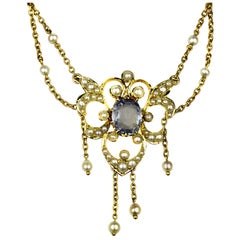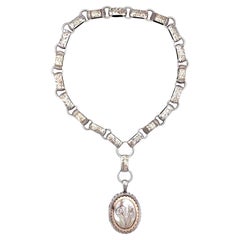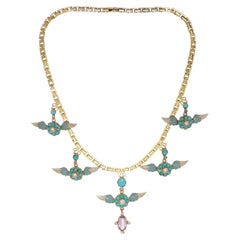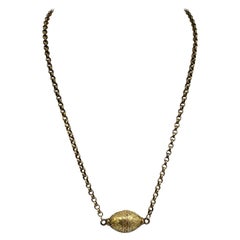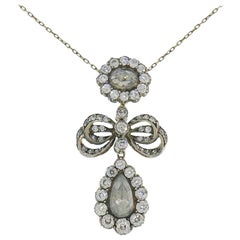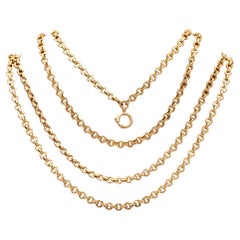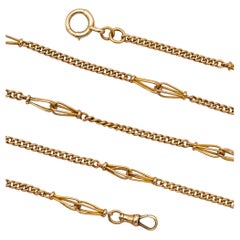Victorian Antique Necklaces
Early 1900s British Victorian Victorian Antique Necklaces
Natural Pearl, Sapphire, 15k Gold, Yellow Gold, Gold
1880s English Victorian Victorian Antique Necklaces
Sterling Silver
1890s European Victorian Antique Necklaces
Yellow Gold, Enamel
Late 19th Century Unknown Victorian Victorian Antique Necklaces
Amber, Amethyst, Silver
Mid-19th Century Unknown Victorian Victorian Antique Necklaces
Gold, 14k Gold, Yellow Gold
Early 1900s Unknown Victorian Victorian Antique Necklaces
Diamond, 14k Gold, Silver
Late 19th Century European Victorian Victorian Antique Necklaces
Gold, 18k Gold, Yellow Gold
Mid-19th Century American Victorian Victorian Antique Necklaces
Gold, 14k Gold, Yellow Gold, Enamel
Late 19th Century European Victorian Victorian Antique Necklaces
Gold, 18k Gold, Yellow Gold
1880s Victorian Antique Necklaces
Gold, 15k Gold
19th Century Victorian Victorian Antique Necklaces
Garnet
1880s Dutch Early Victorian Victorian Antique Necklaces
Diamond, 14k Gold, Silver
19th Century Victorian Victorian Antique Necklaces
Gold, 18k Gold, Yellow Gold
19th Century Victorian Victorian Antique Necklaces
Gold, 18k Gold, Yellow Gold
19th Century American Victorian Victorian Antique Necklaces
Gold
1890s Victorian Victorian Antique Necklaces
Amethyst, Pearl, Gold, 14k Gold, Yellow Gold
1880s Unknown Victorian Victorian Antique Necklaces
Pearl, 15k Gold
1910s Victorian Victorian Antique Necklaces
Diamond, Pearl, Spinel, Tourmaline, Gold
1880s Unknown Victorian Victorian Antique Necklaces
Diamond, Pearl, 15k Gold, Silver, Enamel
19th Century Italian Early Victorian Victorian Antique Necklaces
Diamond, Pearl, 14k Gold
1880s Unknown Victorian Victorian Antique Necklaces
Chalcedony, Pearl, 18k Gold
Late 19th Century Italian Victorian Victorian Antique Necklaces
Coral, Gold Plate, Sterling Silver
1880s Unknown Victorian Victorian Antique Necklaces
Diamond, 15k Gold, Platinum
19th Century Unknown Victorian Victorian Antique Necklaces
Amethyst, Gold, 14k Gold, Yellow Gold
1870s Victorian Victorian Antique Necklaces
Diamond, Natural Pearl, Ruby, 18k Gold, Yellow Gold
1870s European High Victorian Victorian Antique Necklaces
Gold, 18k Gold, Yellow Gold
19th Century Victorian Victorian Antique Necklaces
Diamond, Emerald, Pearl, Gold, 18k Gold, Yellow Gold
Early 1900s Unknown Victorian Victorian Antique Necklaces
9k Gold, Yellow Gold, Enamel
1880s Unknown Victorian Victorian Antique Necklaces
Diamond, Pearl, 15k Gold
Late 19th Century Victorian Victorian Antique Necklaces
Pearl, Blue Zircon, 14k Gold
1870s British Victorian Victorian Antique Necklaces
Gold, 9k Gold
1870s English Late Victorian Victorian Antique Necklaces
Pearl, 15k Gold, Yellow Gold
1880s Italian Victorian Victorian Antique Necklaces
Coral, 9k Gold
1890s Unknown Victorian Antique Necklaces
Diamond, Opal, Gold, 14k Gold, Yellow Gold
19th Century Unknown Victorian Victorian Antique Necklaces
Pearl, Turquoise, Gold, Yellow Gold, 14k Gold
19th Century Unknown Victorian Victorian Antique Necklaces
Amethyst, Pearl, Gold, Yellow Gold, 9k Gold
19th Century Victorian Antique Necklaces
1860s Unknown Victorian Victorian Antique Necklaces
Diamond, Emerald, Pearl, 18k Gold, Silver, Yellow Gold
1880s British Victorian Victorian Antique Necklaces
Diamond, Pearl
Early 20th Century Unknown Edwardian Victorian Antique Necklaces
Diamond, Pearl, Platinum, 14k Gold, Enamel
Late 19th Century English Victorian Victorian Antique Necklaces
Pearl, Gold, 18k Gold, Enamel
1880s French Victorian Antique Necklaces
Gold, 18k Gold, Yellow Gold
1880s Unknown Victorian Victorian Antique Necklaces
Diamond, Sapphire, Gold, 14k Gold, 9k Gold, Silver
19th Century Unknown Victorian Victorian Antique Necklaces
Opal, Rock Crystal, Gold, 14k Gold, Yellow Gold
Late 19th Century English Victorian Victorian Antique Necklaces
Gold, 15k Gold, Rose Gold, Yellow Gold
1870s Victorian Antique Necklaces
Pearl, Yellow Gold
19th Century Unknown Victorian Antique Necklaces
Lapis Lazuli, Yellow Gold
Early 20th Century Unknown Art Deco Victorian Antique Necklaces
Diamond, Pearl, 14k Gold, White Gold, Yellow Gold
1880s Victorian Antique Necklaces
Pearl, Yellow Gold
1880s Victorian Victorian Antique Necklaces
Opal, Pearl, Gold, 14k Gold, Yellow Gold
19th Century European Victorian Victorian Antique Necklaces
Carnelian, Lapis Lazuli, Multi-gemstone, 14k Gold
Late 19th Century Unknown Victorian Antique Necklaces
Diamond, 18k Gold, Yellow Gold
1890s Victorian Antique Necklaces
Diamond, Opal, Yellow Gold
1890s Unknown Victorian Antique Necklaces
Diamond, Pearl, 15k Gold, Yellow Gold
19th Century European Victorian Victorian Antique Necklaces
Amethyst, Citrine, Rock Crystal, 9k Gold
1880s English Etruscan Revival Victorian Antique Necklaces
Pearl, Natural Pearl, Gold, Yellow Gold, Enamel
1880s British Victorian Victorian Antique Necklaces
Silver
1880s American Late Victorian Victorian Antique Necklaces
Sterling Silver
1880s British Victorian Victorian Antique Necklaces
Silver
Late 19th Century American Victorian Victorian Antique Necklaces
Brass
- 1
- ...
Victorian Antique Necklaces For Sale on 1stDibs
How Much are Victorian Antique Necklaces?
A Close Look at Victorian Jewelry
The reign of Queen Victoria encapsulates a quickly evolving period of history — and jewelry styles were no exception. No single period has seen such a diverse group of jewelry attributed to it than the Victorian era. Today, there is a vast collection of authentic antique Victorian jewelry and watches on 1stDibs.
Victorian jewelry is named after Queen Victoria, whose reign lasted from 1837 to 1901, making her the second longest-ruling monarch. (She was surpassed by Queen Elizabeth II in 2015.) During this time, different styles of fashion and jewelry came and went. Thanks to our fascination with royalty and swoon-worthy melodramas like Netflix’s The Crown — which is rife with evocative fashion, jewelry and interiors — and the 2017 feature film Victoria & Abdul, we are all familiar with her story. After the death of Victoria’s father and three childless uncles, she ascended to the throne at age 18. In 1840, Queen Victoria married the love of her life, her first cousin Prince Albert of Saxe-Coburg and Gotha.
Queen Victoria loved serpentine jewels, and she had even more power to shape trends than Kate Middleton and Meghan Markle do today. The British monarch’s best-known piece in this mold is the gold coiled-snake engagement ring she received from Prince Albert — the sinuous reptile was considered a symbol of everlasting love.
The Queen's 63-year reign has been divided by historians into the Romantic period, the early happy years, circa 1837–60; the Grand period, marked by the deaths of the Queen’s mother and husband, circa 1860–80; and the late Victorian or Aesthetic period, which lasted from about 1880 until 1901 and ushered in the Belle Époque. Queen Victoria wore her heart on her sleeve, and her fashion and jewelry reflected her emotions.
Romantic period jewelry, which featured common decorative motifs and was embellished with seed pearls, coral and turquoise, was a celebration of the young monarch’s love. Everything changed with the death of Prince Albert, and the Grand period is most often associated with mourning jewelry. Jewelry was smaller, lighter and more dainty during the late Victorian period. During this era, diamonds came into fashion, and semiprecious gems such as amethysts and opals became prevalent, too. Using gemstones for their natural beauty and not their worth was something that jewelers of the era felt passionate about, and this ideology would really become relevant in Art Nouveau jewelry.
Find a collection of authentic antique Victorian jewelry — from rings, necklaces and brooches to a range of other accessories — on 1stDibs.
Why Gold Shines in Jewelry Craftsmanship
Gold is the feel-good metal, the serotonin of jewelry. Wear vintage and antique gold necklaces, watches, gold bracelets or gold rings and you feel happy, you feel dressed, you feel, well, yourself.
Gold, especially yellow gold, with its rich patina and ancient pedigree going back thousands of years, is the steady standby, the well-mannered metal of choice. Any discussion of this lustrous metal comes down to a basic truth: Gold is elementary, my dear. Gold jewelry that couples the mystique of the metal with superb design and craftsmanship achieves the status of an enduring classic. Many luxury houses have given us some of our most treasured and lasting examples of gold jewelry over the years.
Since its founding, in 1837, Tiffany & Co. has built its reputation on its company jewelry as well as its coterie of boutique designers, which has included Jean Schlumberger, Donald Claflin, Angela Cummings and Elsa Peretti. There are numerous gold Tiffany classics worth citing. Some are accented with gemstones, but all stand out for their design and the workmanship displayed.
For the woman who prefers a minimalist look, the Tiffany & Co. twist bangle (thin, slightly ovoid) is stylishly simple. For Cummings devotees, signature pieces feature hard stone inlay, such as her pairs of gold ear clips inlaid with black jade (a play on the classic Chanel black and tan), or bangles whose design recalls ocean waves, with undulating lines of lapis lazuli and mother-of-pearl. And just about any design by the great Jean Schlumberger is by definition a classic.
Even had he eschewed stones and diamonds, Southern-born David Webb would be hailed for the vast arsenal of heavy gold jewelry he designed. Gold, usually hammered or textured in some manner, defines great David Webb jewelry. The self-taught jeweler made very au courant pieces while drawing inspiration from ancient and out-of-the-way sources — East meets West in the commanding gold necklaces made by Webb in the early 1970s. The same could be said for his endlessly varied gold cuffs.
In Europe, many houses have given us gold jewelry that sets the highest standard for excellence, pieces that were highly sought after when they were made and continue to be so.
Numerous designs from Cartier are homages to gold. There are the classic Trinity rings, necklaces and bracelets — trifectas of yellow, white and rose gold. As a testament to the power of love, consider the endurance of the Cartier Love bracelet.
Aldo Cipullo, Cartier’s top in-house designer from the late 1960s into the early ’70s, made history in 1969 with the Love bracelet. Cipullo frequently said that the Love bracelet was born of a sleepless night contemplating a love affair gone wrong and his realization that “the only remnants he possessed of the romance were memories.” He distilled the urge to keep a loved one close into a slim 18-karat gold bangle.
BVLGARI and its coin jewelry, gemme nummarie, hit the jackpot when the line launched in the 1960s. The line has been perennially popular. BVLGARI coin jewelry features ancient Greek and Roman coins embedded in striking gold mounts, usually hung on thick link necklaces of varying lengths. In the 1970s, BVLGARI introduced the Tubogas line, most often made in yellow gold. The Tubogas watches are classics, and then there is the Serpenti, the house's outstanding snake-themed watches and bracelets.
A collection called Monete that incorporated the gold coins is one of several iconic BVLGARI lines that debuted in the 1970s and ’80s, catering to a new generation of empowered women. Just as designers like Halston and Yves Saint Laurent were popularizing fuss-free ready-to-wear fashion for women on the go, BVLGARI offered jewels to be lived in.
Since Van Cleef & Arpels opened its Place Vendôme doors in 1906, collection after collection of jewelry classics have enchanted the public. As predominantly expressed in a honeycomb of gold, there is the Ludo watch and accessories, circa the 1920s, and the golden Zip necklace, 1951, whose ingenious transformation of the traditional zipper was originally proposed by the Duchess of Windsor. Van Cleef's Alhambra, with its Moroccan motif, was introduced in 1968 and from the start its popularity pivoted on royalty and celebrity status. It remains one of VCA’s most popular and collected styles.
Mention must be made of Buccellati, whose name is synonymous with gold so finely spun that it suggests tapestry. The house’s many gold bracelets, typically embellished with a few or many diamonds, signified taste and distinction and are always in favor on the secondary market. Other important mid-20th-century houses known for their gold-themed jewelry include Hermès and Ilias Lalaounis.
Find a stunning collection of vintage and antique gold jewelry on 1stDibs.
Finding the Right Necklaces for You
We are fortunate to know much of the world’s long and dazzling history of necklaces, as this type of jewelry was so treasured that it was frequently buried with its owners. Today, Van Cleef necklaces, Tiffany necklaces and Cartier necklaces are some of the most popularly searched designer necklaces on 1stDibs.
Lapis lazuli beads adorned necklaces unearthed from the royal graves at the ancient Iraqi civilization of Sumer, while the excavation of King Tut’s burial chamber revealed a sense of style that led to a frenzy of Art Deco designs, with artisans of the 1920s seeking to emulate the elegant work crafted by Ancient Egypt’s goldsmiths and jewelry makers.
In ancient times, pendant necklaces worn by royalty and nobles conferred wealth and prestige. Today, wearing jewelry is about personal expression: Luxury diamond necklaces exude confidence and can symbolize the celebratory nature of a deep romantic relationship, while paper-clip chain-link necklaces designed by the likes of goldsmith Faye Kim are firmly planted in the past as well as the present. Kim works exclusively with eco-friendly gold, and these fashionable, fun accessories owe to the design of 19th-century watch fobs.
For some, necklaces are thought of as being a solely feminine piece, but this widely loved accessory has been gender-neutral for eons. In fact, just as women rarely took to wearing a single necklace during the Renaissance, men of the era layered chains and valuable pendants atop their bejeweled clothing. In modern times, the free-spirited hippie and counterculture movements of the 1960s saw costume-jewelry designers celebrating self-expression through colorful multistrand necklaces and no shortage of beads, which were worn by anyone and everyone.
Even after all of these years, the necklace remains an irrefutable staple of any complete outfit. Although new trends in jewelry are constantly emerging, the glamour and beauty of the past continue to inform modern styles and designs. In a way, the cyclical history of the necklace differs little from its familiar looped form: The celebrated French jewelry house Van Cleef & Arpels found much inspiration in King Tut, and, now, their Alhambra collection is a go-to for modern royals. Vintage David Webb necklaces — whose work landed him on the cover of Vogue in 1950, two years after opening his Manhattan shop — were likely inspired by the ornamental styles of ancient Greece, Mesopotamia and Egypt.
On 1stDibs, browse top designers like Dior, Chanel and Bulgari, or shop by your favorite style, from eye-catching choker necklaces to understated links to pearl necklaces and more.
- 1stDibs ExpertDecember 4, 2023To tell if a necklace is antique, first look for hallmarks that indicate the maker. If you locate them, you can consult trusted online resources to find out when the company or artisan was active. To qualify as an antique, a necklace must be at least 100 years old. The presence of materials that are no longer commonly used to produce jewelry, like bakelite, camphor glass, foil opals and paste, can be good indicators that a piece is an antique. Antique jewelry is also more likely to have European- and rose-cut gemstones than modern cuts like the brilliant round. Because it can be difficult to date jewelry on your own, you may wish to consult an expert, like a certified appraiser or experienced dealer, for assistance. On 1stDibs, shop a large collection of antique necklaces.
